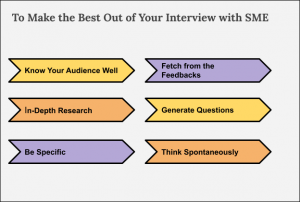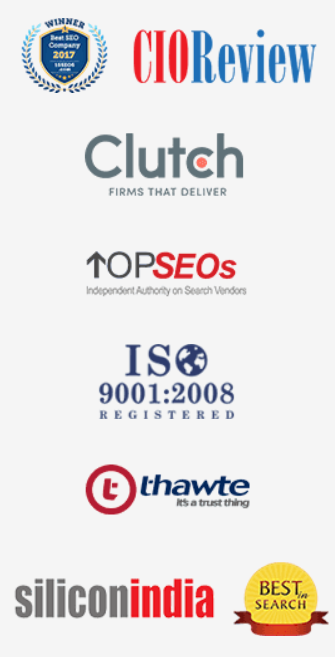Content Marketing is all about influencing your target audience and making them confident in your services. It’s all about owning “Thought Leadership” – not a monopoly but authority in your respective sector.
Keep reading to know what is thought leadership? Its significance, benefits, and how you can establish your business authenticity in the market through Thought Leadership…
What is Thought Leadership?
Thought Leadership (in business) is a part of content marketing strategy through which a company demonstrates its ideas and expertise to have a never-ending influence on its target audience. Being in a business, you express your passion and talent while consistently answering all the questions in the minds of your target audience to get them highly confident in you.
Most often “thought leaders” are called in the seminars and webinars to influence their listeners but talking about a business the two major tools for thought leadership are well-curated content and social media influence.
Far away from mimicking the ancient lines, you need to provide crystal clear insight into your products by giving the deepest answers to your customers in a way that is quick for them to consume. Keep yourself on the same page with your audience.
The “Unique Point of View Trap”
Any content marketing is successful only if it has thought leadership but some executives are stuck with the concept of “unique point of view” and the USP.
They believe that amidst a significant resonance in the market if one has to be audible they need to have differentiated and unique SP every time they speak to their audience.
But is it possible that not every time your audience is looking for something unique but the most satisfying answers to their questions?
The best Route: make a unique point of view (as and when applicable), also make a difference with your visual designs but most dominantly make a difference by becoming an authority and serving your audience with insights and different types of content every day.
Roadmap to the “Thought Leadership Approach”
If you want to hold an upper hand in the market, influence, and guide your target audience, here is how you can do it… Follow the same lead…
1. In-Depth Research
The only roadmap to establish your authority and influence in the market is loaded research. Do not leave any tangent unattended. .you can be confident in your product only when you are entirely familiar with it.
2. Know Your Customers’ Challenges
You must be well aware of the challenges your customers are facing and how your product can benefit them. Bet on their benefits and you will always win. Several businesses have leveraged this technique.
3. Spontaneous Interaction
Actively interact with your target audience to make yourself audible enough in the crowd. Make sure to know that you are only doing content marketing or are actually into thought leadership.
4. Do Not Let Down Your Trust
Disclaimer: The moment you come out with your promotional approach there will be a reaction from your target audience (positive or negative). Make sure that doesn’t let you lose faith in your product. Trust is the first pillar and apparently the strongest one based on which you can influence your audience.
Where do you need to use Thought Leadership Marketing?
Thought Leadership is important to build trust and influence. This approach is important for both B2C and B2B companies.
B2B – There are complexities in the decision-making process of B2B firms. Complexities here indicate the amount of time taken in the decision-making process, the budget preferences, and the number of people/departments involved. This is where thought leadership comes to its optimum mode in B2B content marketing. In short, thought leadership helps the person in the decision-making process to maintain an alignment with his peers which is as hard as it is important for successful marketing.
B2C – For B2C marketers or sales executives, thought leadership helps you define the category of your business solution and in turn build your brand value on the customer’s end. So, thought leadership is your best bet here as it will effectively support your business goals, retain your clientele and eventually establish your authority in your segment. After all, everything relies on relating to the consumer’s specific needs.
Sources of Thought Leadership
Is Thought Leadership only the definitive role of sales executives? Breaking such stereotypes, thought leadership can come from any source – executives, customers, project managers, sales reps, CS Dept, SMEs, etc. anyone who is associated with the business is more likely to have the knowledge, experience, and a unique point of view.
Do not force it on your acquaintances. You can ask them but can’t force them to share their expertise. Conduct programs to highlight those who are willing to volunteer.
The source could be any but the ultimate goal is still the same, influencing the customers to take action on your thought leadership approach.
Getting the Leads on Thought Leadership from Search Matter Experts
SME is a person with bonafide knowledge and research skills about a specific subject, business area, and both the marketing & technical paradigm of a project.
Thought leadership can reduce your sales cycles and help you achieve your targets before time. But.. only if they are done correctly. Most of the researches shows that B2Bs are highly influenced by thought leadership content. Take help from SMEs to increase your brand’s credibility, value, and sales.
For productive sessions with SME, here is what you need to do…

1. Know Your Audience Well
As it is said you should know on which land you are stepping. You must know your target audience before strategizing, designing, and writing your content. Being in a business, you must know about your target audience before holding any session with the SME.
2. Fetch From the Feedbacks
Sometimes we dictate our ideas to our clients while other times our clients toss their ideas to us making the best SMEs for that moment. In order to fetch something from our conversation, we can ask them to send feedback or key points about a topic/service based on which we organize our research and interview.
3. Do In-Depth Research
Experts are there to guide you but it would save a lot of time if you own prior knowledge of the topic. You are always expected to have a general understanding of your topic. This includes online research, surveys on your target audience (demands and preferences), scrutinizing social media (for B2C its Insta and Facebook, for B2B it’s LinkedIn).
4. Generate Questions
Jot down as many questions as you can so that you are now awfully quiet when it comes to taking suggestions from your SME. You will certainly go speechless without a prior piece of information and questions. Before every interview, make it a habit to send your SMEs the list of questions you have prepared.
5. Be Specific
To gain more from your interaction with SMEs make sure you are specific with your conversation. Asking specific questions and let them provide specific examples about a topic. Try going for real-life client examples for a better understanding of the topic.
6. Think Spontaneous
As your interview with SME is not casual, you cannot afford to be lethargic. Spontaneous thinking is a must. Also, you need to analyze that you are getting what you wanted from the SME or if this conversation taking a different direction.
The objective is to dig deeper into the topic and come out with innovative thoughts.
7. Ask
Ask your SMEs if they have any additional inputs regarding the topic. It can be a simple question or a piece of conversation or just a revision of what was discussed earlier can raise some important leads.
Challenges with Thought Leadership Strategies
It is an undeniable fact that thought leadership has made several businesses reach heights. This result-driven content strategy has a bright future but not without challenges…
Challenges that come with Thought Leadership Strategies:
1. Thought Leadership is not about gaining followers on social media. It is an ongoing process of educating your target audience about your product and building their trust. Making consistent trust and authority is hard.
2. Content fails in terms of thought leadership if it does not have a driver and directions. The content will never help you achieve your goals.
3. All the pieces of content from blog posts to guests posts, whitepapers, speeches, engagements, etc should work together and speak the same idea. Contrasting content might lead to a question on your brand value.
4. Misaligned strategies will lead to a lot of content but with very little influence.
Enhance Your Thought Leadership Strategy
Content can attach or detach you from your target audience. Always aim for the latter. Here are some points that will help you create your thought leadership content that will lead you towards your goal…
Make a stronger thought leadership strategy:
1. Know How to Build Trust
Let go of the promotional stuff for once. Gain your audience’s trust by offering them something for nothing. When you divert your attention from promoting your business to providing the actual real-life value information/leads to the people they will start trusting you. So give them the valuable information they can rely on.
Let your content help them with their needs, solve a problem, or simply entertain them.
2. Top-Notch and Related Content Planning for the Journey
Now that you are well-versed with the power of content and the internet, you can stress building-specific content highlighting specific points to strengthen your relationship with your audience.
Writing blogs and guest posts and posting them on reputed sites for your target audience to read is a great start. Once you have their attention then keep them engaged with installments of meaningful content, videos, storytelling, downloadable resources, and a lot more.
3. Putting content to work
Most people think that creating relatable, thought leadership content is enough. No, it’s more than that. Content is just a tool that needs to be applied correctly in front of the correct audience to maximize the gains. Sway through your most valuable contacts/audiences and serve them the pieces from which they will benefit the most.
Content helps you enhance your online presence as well, make sure to surround your brand with good quality content.
Do B2B firms apply Thought Leadership?
A properly curated and executed thought leadership content holds an ultimate card in expressing B2B firm’s market authority. It can boost a company’s reputation in the market and support them with maintaining consistency, authority and influence.
Yes B2B businesses need that. As per the survey by Gist, 84% of the FTSE’s 350 executives rely on robust thought leadership content to not only fetch attention but add value to their brand.
Apparently, two of the five business leaders will approach content marketing experts (minds behind developing the thought leadership content), if they feel like it picks the right nerve.
Is Your Thought Leadership Content Persuasive Enough?
Despite being the most promising concept, senior executives read only 31% of the material assuming that the crux is served to them. Out of that proportion too, 28% are able to actually influence their decisions.
When asked the reason to bounce back from the thought leadership content, C-level complains the content to be:
-> Too generic and mundane (63%)
-> Doesn’t serve the purpose and ideas (58%)
-> Promotes the firm (who has originally written it) to engagement and addressing needs. (53%)
Test Your Thought Leadership
One of the major purposes of thought leadership is getting on the same page with your target audience and addressing the concerns that are high on their lists. This comes with research, knowing your clients, customer feedback & engagement, guidance from SME, sales teams/marketing teams, and a lot more…
Your market resonance and relation with your audience is the parameter that determines how incisive you are with your thought leadership. And if it fails to create any influence, then you need to re-think your strategies.
| Thought Leadership Tests |
|
1. Client Gains
Good quality content directly strikes the minds of the viewers provoking interest in them. But a business focusing only on promotions and without paying much attention to client’s problems, then that’s quite a deal-breaker.
2. Authenticity
Maybe the content is too generic or lacks originality. If it is quite common that the audience comes to a blog with the same topic they have read before, the second makes them uninterested.
3. Business Expertise
In the run to fetch attention, do not forget trust. Make your expertise clear to your audience (not with direct but indirect marketing). There is no point in creating an original and interactive piece of content if it doesn’t clearly define your goals/expertise. Or your clients’ purposes.
4. Media influence
Media and journalists are the true testers of your thought leadership quality. If they do not find any interesting crux then they will not write about it. Give your content a trial run by sharing them with friendly journalists. Will they be able to create a story that people want?
How to create result-driven Thought Leadership?
Follow the lead…
1. Fetch for relevant Topics
Fetch the topics that are closely associated with your business goals. Create situations and tell your target audience what you’re offering. Apart from your direct competitors, you are fighting with everyone that publishes content on the internet – the race is for the authenticity of the content.
2. Identify your client’s question
Identify your client’s questions and serve them with just the apt solution for the same. Your brand promotion is automatically done if your clients are getting the answers to their questions.
3. Ignite conversations and Engagement
One of the best qualities of thought leadership content, it keeps your target audience engaged. Use examples, facts quotes supporting the essence of your content. The best way to generate quality and relatable content is by interviewing the customers. Fetch the outcomes and curate the content with your client’s perspective rather than your own perspective.
Conclusion
Thought leadership is important for any business to rule. Knowing what your clients want, solving their problems, building trust with your audience are above simple promotions and will lead to long-term relationships with your clients having your business’s authority in the market.
If you wish to discuss more on developing and deploying thought leadership content we are open to discussions and planning.






